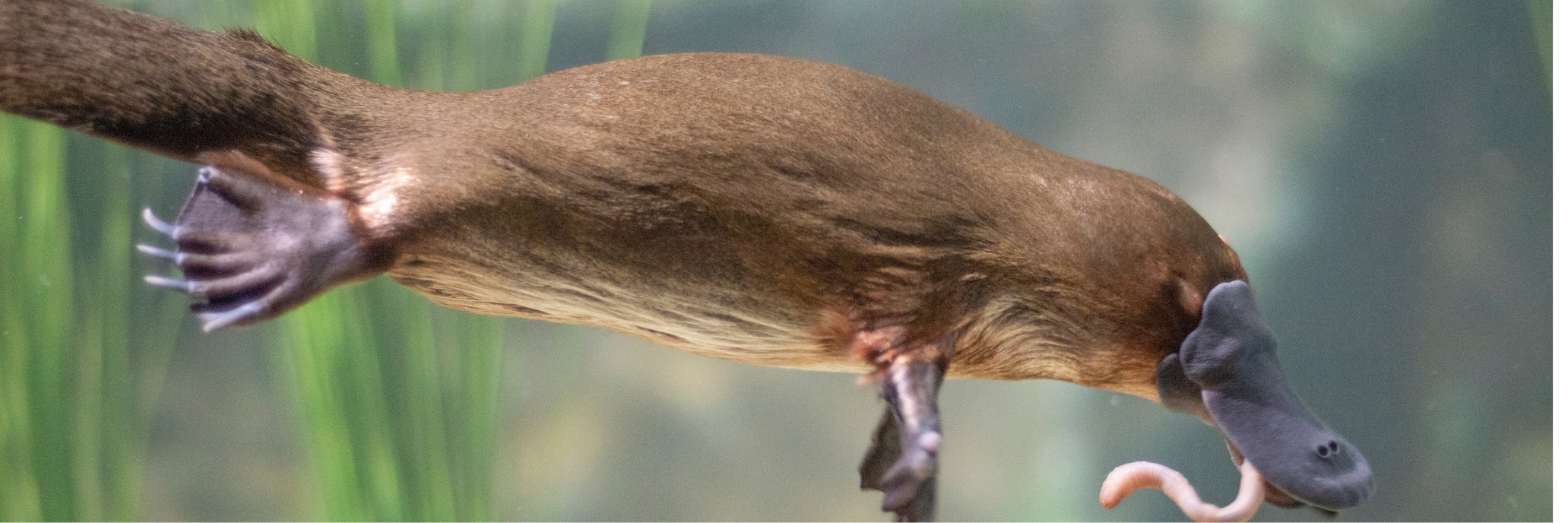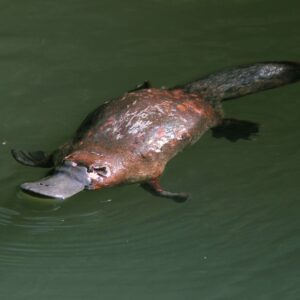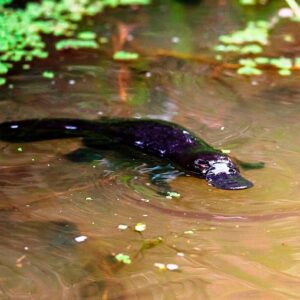Platypus Spotting at Peterson Creek, Yungaburra
Platypus
- The platypus is one of only five egg-laying mammals (monotremes) in the world—and it’s found right here in the Atherton Tablelands.
- Best viewing times are dawn and dusk, when the platypus is most active and likely to be feeding or playing in the water.
- They prefer calm, clean freshwater creeks, making the Tablelands’ spring-fed waterways the perfect habitat.
- Platypus are shy by nature, so move quietly, avoid sudden movements, and keep your voice down for the best chance to see one.
- They’re excellent swimmers, using their webbed front feet to glide effortlessly through the water while searching for food.
- Yungaburra’s Peterson Creek is one of the best-known spots for wild platypus sightings, complete with a designated viewing platform.
- Local guided wildlife tours can increase your chances of spotting one, especially if you’re short on time or new to wildlife watching.
Discover Platypus

Nestled in the charming village of Yungaburra, Peterson Creek is a hidden gem where you can experience the thrill of spotting one of Australia’s most elusive creatures, the platypus. Here’s everything you need to know for a memorable wildlife adventure.
About Platypus: Australia’s Unique Water Marvel
Introduction
The platypus is one of Australia’s most fascinating and unique creatures. With its duck-bill, webbed feet, and beaver-like tail, the platypus is a curious blend of various animals, making it a true wonder of nature. Here’s everything you need to know about this extraordinary mammal.
Physical Characteristics
- Distinctive Features: The platypus stands out with its duck-like bill, which is highly sensitive and used to detect prey in the water. Its webbed feet make it an excellent swimmer, while the beaver-like tail stores fat reserves and aids in swimming.
- Size and Appearance: Platypuses are relatively small, with males typically measuring about 50 cm (20 inches) in length, including the tail, and females slightly smaller. Their fur is dense and waterproof, keeping them warm in cold water.
Habitat and Distribution
- Natural Habitat: Platypuses in freshwater environments such as rivers, streams, and lakes across eastern Australia, including Tasmania. They prefer habitats with abundant vegetation and stable water levels.
- Burrows: They create burrows in the banks of rivers and streams, where they rest and raise their young. The entrance to the burrow is usually above the waterline, protecting it it from predators and floods.
Behaviour and Diet
- Nocturnal Lifestyle: Platypuses are primarily nocturnal and crepuscular, meaning they are most active during the night and twilight. This behaviour helps them avoid many predators.
- Feeding Habits: Their diet mainly consists of aquatic invertebrates such as insects, larvae, and small crustaceans. They forage by diving underwater and using their sensitive bills to detect prey.
- Unique Foraging: When hunting, platypuses close their eyes, ears, and nostrils, relying entirely on their bill’s electroreceptors to locate food. They store captured prey in cheek pouches and consume it once they surface.
Reproduction and Lifespan
- Egg-Laying Mammal: The platypus is one of only five extant species of monotremes, or egg-laying mammals. Females lay one to three eggs and incubate them by curling around them for about ten days.
- Young platypuses: After hatching, the young eat milk the mother secretes through specialised mammary gland ducts. Platypuses lack nipples.
- Lifespan: Platypuses typically live up to 11 years in the wild, though some individuals have been known to live longer.
Conservation Status
- Protected Species: While not currently endangered, the platypus is considered a near-threatened species. Habitat destruction, water pollution, and climate change threaten their populations significantly.
- Conservation Efforts: Various conservation programs and protected areas aim to preserve platypus habitats and promote research to ensure survival.
📍 Where to Spot a Platypus – Atherton Tablelands Guide
🦆 Peterson Creek, Yungaburra
A local favourite with a scenic walking trail and a dedicated platypus viewing platform. You may also see turtles and kingfishers along the way!
🦆 Tarzali Lakes
Privately-owned eco property offering guided wildlife spotting experiences. A great place to view platypus in a tranquil, managed setting.
🦆 Atherton Platypus Viewing Platform
Just outside of Atherton, this elevated platform overlooks a calm stretch of creek frequented by platypus and other native wildlife.
🦆 Malanda Falls Conservation Park
While sightings are less common here, it’s a peaceful spot for early morning walks, and you might just be lucky!
🦆 Brooks Road, near Peeramon
A lesser-known local gem—ask at visitor centres for directions. Some visitors have reported lucky sightings in the quieter creek areas.
Fun Facts
- Venomous Spur: Male platypuses have a venomous spur on their hind legs, used during fights with rivals. While not lethal to humans, the venom can cause severe pain and swelling.
- Evolutionary Mystery: The platypus’s unique characteristics puzzled early European naturalists, with some initially believing it was a hoax.
Why Peterson Creek?
- Prime Platypus Habitat: Peterson Creek’s calm, clear waters and lush surroundings create an ideal platypus habitat. The area is renowned for its high chances of sightings, making it a must-visit for nature enthusiasts.
- Tranquil Setting: Peterson Creek’s serene environment offers a peaceful retreat. The gentle sounds of the creek and the rustling leaves set the perfect backdrop for wildlife watching.
Best Time to Visit
- Early Morning or Late Afternoon: Platypuses are most active during the early morning and late afternoon. Arrive just after dawn or a few hours before dusk for the best chance of a sighting.
- Quiet Observation: Patience and silence are keys. Sit quietly by the creek and watch for the telltale ripples on the water’s surface, indicating a nearby platypus.
Best Time of Day to See a Platypus
Spotting a platypus in the wild is a truly magical experience, but it requires patience and perfect timing. These shy creatures are incredibly elusive, so understanding their habits can greatly increase your chances of a sighting.
Dawn and Dusk: Prime Viewing Times
Platypuses are nocturnal animals, meaning they are most active during the twilight hours. Your best chance of seeing one is at dawn or dusk when they come out to feed. Plan your visits accordingly, and be prepared to arrive early in the morning or stay late into the evening.
The Right Conditions
Platypuses prefer dark and gloomy weather, making overcast days ideal for sightings. The reduced light and quieter environment make them feel safer, increasing the likelihood that they will emerge from their burrows. Choose a day with overcast skies to improve your chances if you can.
A Memorable Experience
With luck and patience, everything may come together to glimpse this fantastic animal—many people who have seen platypuses in the wild count it among their most unforgettable wildlife experiences. The thrill of spotting this elusive creature in its natural habitat is well worth the wait.
Understanding their habits and choosing the right time and conditions can significantly enhance your chances of seeing a platypus. So plan your trip, pack your patience, and prepare for a potentially magical encounter with one of Australia’s most unique animals.
Walking Tracks and Viewing Platforms
- Platypus Viewing Platform: A dedicated viewing platform along Peterson Creek provides an excellent vantage point for spotting platypuses. The platform is designed to offer great views without disturbing the natural habitat.
- Walking Trails: The Peterson Creek Wildlife and Botanical Walking Track meanders along the creek, offering multiple spots to stop and watch for platypuses. The trail also showcases the area’s diverse flora and fauna.
Other Wildlife
- Diverse Ecosystem: While searching for platypuses, watch for other wildlife. Peterson Creek is home to various birds, turtles, and even tree kangaroos. Each visit offers a unique wildlife experience.
- Birdwatching: The creek is a haven for birdwatchers, with species like kingfishers, herons, and parrots frequently seen in the area.
Enjoy Yungaburra
- Local Cafes and Shops: After your platypus spotting adventure, take some time to explore the quaint village of Yungaburra. Enjoy a coffee at one of the local cafes or browse the charming shops and galleries.
- Curtain Fig Tree: Don’t miss the nearby Curtain Fig Tree, a magnificent natural wonder just a short drive from Peterson Creek. This iconic fig tree is one of the largest in North Queensland and well worth a visit.
❓ Frequently Asked Questions – Platypus Spotting
When is the best time to see a platypus in the Tablelands?
Where can I see a platypus in the wild?
Are platypus dangerous?
Can I take a photo of a platypus?
What should I bring when going platypus spotting?
Platypus spotting at Peterson Creek in Yungaburra offers a magical glimpse into the life of one of Australia’s most unique animals. With patience and the right timing, you will indeed have an unforgettable wildlife experience. Happy spotting!












